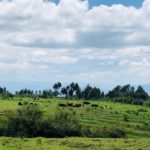Living on a Safari in Mozambique

The wonderful thing about life in Africa is that no two days are the same, and nothing ever goes according to plan. I spent three months with Luwire in the Niassa Reserve in Northern Mozambique, and here’s what a “typical day” looked like.
Living on a Safari in Mozambique
6 AM
Days began with monkeys practicing “tent gymnastics” on the canvas roof of the eight luxury tents in Lugenda Wilderness Camp. They began with the long jump, throwing themselves along the tent, then a 100m sprint and finally a high jump into the surrounding trees to escape the grumpy resident as I emerged. After making coffee with water from over the fire, we had radio call, when the camps and scout posts exchanged information and plans for the day.
After radio call, we took Dobby, the rescue Samango monkey, to the trees for his breakfast of figs, leaves and insects. Dobby was rescued when he was only a few days old after being separated from his troop, and was hand-reared until he was four months old. It was my job to take him to the reserve to help him rehabilitate into the wild. We taught him how to be a monkey–harder than it sounds when he thinks he’s human and doesn’t know how to climb trees!
We then had breakfast with the safari guests; food is beautifully prepared by the cooks who are local village people–everything is driven from the headquarters in Pemba on Mozambique’s coast, which is 12 hours away!
8 AM
After clearing breakfast with the help of Singi, the rescue African wildcat, who gets the scraps (if she can keep the monkey away!), we prepared for the morning activities. We piled into the Land Cruiser with cameras and binoculars for a game drive. The animals are active in the mornings and evenings, avoiding the midday heat by sleeping in the shade. We drove around the dirt roads in the concession, seeing which animals decided to show themselves.
There are many types of antelope, including a large population of impala, waterbuck, sable, buffalo, eland, hartebeest, zebra and the Niassa wildebeest, unique to the reserve (to name but a few). The elephants are the stars of the show, and the concession boasts the highest density in Mozambique. Ivory poaching has hit the reserve hard but thanks to the scouts that patrol the area, Luwire has managed to keep the elephants well protected.
Predators are harder to find and are always a special sight–the lion and leopard are supported by the large numbers of antelope. Hyenas and jackals are elusive and seldom seen, but always heard at night. Whatever we saw was special, and the guides would always find interesting animals if they left tracks. The drives included morning tea on an inselberg with a wonderful view. We also had to apply cream to the many tsetse fly bites we were inevitably covered in!
11 AM
When things quietened down, we returned to camp to freshen up. I took Dobby to the trees to practice climbing in order to build his confidence and muscles. He spent mornings with Singi the cat, roaming around camp, causing havoc and stealing as much food as possible! He’s very affectionate and guests often played with him–not an average safari experience.
After lunch in camp, guests had free time to relax. The heat of the day meant that the animals were hiding and Dobby would come to my tent for a nap and a cuddle. Some days, I helped out in the kitchen, making dessert for the evening and teaching baking skills to the cooks.
3 PM
While drinking afternoon tea, Dobby always tried to steal food from unsuspecting clients and we’d hide apples in the trees to keep him entertained! We would then hop in the car for an evening drive, just as it started to cool down and the beautiful game came out of hiding. We would drive up an inselberg for sunset, sometimes cooking dinner al fresco; it took a lot of preparation so this was usually a special ‘last-night’ treat for the guests.
The sunsets from the inselbergs are spectacular, and when it became dark, the tracker would use a torch to seek out nocturnal animals on the drive. Most of the antelope were asleep, but predators are more active and nocturnal animals such as civets, spotted genets and even honey badgers could be seen, as well as smaller creatures such as bats, bushbabies and chameleons.
8 PM
If we hadn’t eaten on the mountain, we would drive to camp for dinner. I spent my nights trying to get Dobby to stay asleep on his teddy bear in the tree! Dinner was always wonderful and we were often visited by elephants as they passed through camp to reach the river.
The generator was turned on and allowed us a small amount of electricity to charge things and eat with light. Once everyone had eaten and was tired enough, we retired to bed for a night of lions and hyenas calling, and elephants bumping the tent–a surreal experience.
When there were no guests present, my days were a lot quieter and involved spending time in camp fixing things, doing office work, or wandering in the bush and exploring new areas. My three months living on a safari in Mozambique were unforgettable!
Photo for Living on a Safari in Mozambique by Unsplash.








